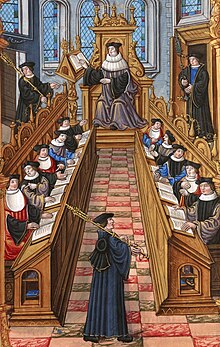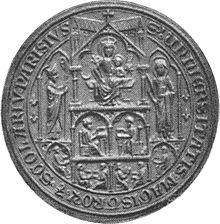University of Paris
The University of Paris was the entirety of the most important academic teaching institutions in Paris, not least the Sorbonne , whose name became the synonymous name of the university in common parlance. It survived the monarchy, revolution and restoration , but not the student unrest of 1968 . Since 1970 there has been such a thorough decentralization and wave of start-ups that it is difficult to identify the traditional succession. The Paris Universitas (2005–2010) was the closest to the old University of Paris.
The old university
The universitas magistrorum et scholarium (association of teachers and scholars ) was recognized by Philip II in 1200 . The more class than scientific institution was placed under the jurisdiction of the church . The purpose was to withdraw the students, who were sometimes perceived by the population as a nuisance, from the perhaps somewhat rude access of their security organs. After all, they were theologians, the future representatives of the Church. From church welfare colleges developed that were supposed to make life easier for students in Paris by providing cheap housing. The most important was the Collège de Sorbonne for budding theologians. Colleges oriented towards the national team were also set up. The names of today's student associations are a reminder of this development. All together formed the Latin Quarter . Furthermore, four faculties developed in the end: La Faculté des arts de Paris with the task of a kind of basic course in the liberal arts and the higher faculties of law, medicine and theology.
The heroes of this era include Albertus Magnus (1200–1280), Bonaventure (1221–1274), Thomas Aquinas (1225–1274) and Boetius von Dacien .
The oriental schism brought fame and honor to the theologians and canon lawyers at the university. The Western Schism , a French affair, led to an alienation from Rome. The scholars at Paris University rejected the expansion of papal power in the early modern period, as did the reformist aspirations of Jansenism . They became spokesmen for Gallicanism , a close connection between the Catholic Church in France and royalty. This in turn led to the university's loss of influence and reputation. Absolutism and the Enlightenment were everywhere driving forces for new foundations, but in France they led to the closure of the university during the French Revolution in 1793. The entire educational system from school onwards became a matter for the nation. The friend of the sciences, Napoléon Bonaparte , replaced the 23 old universities with a network of educational authorities and educational establishments extending from Paris across all departments, the center of which was the University of Paris.
The new university
Only during the Third Republic under Félix Faure was the Université de Paris (now called nouvelle université de Paris ) set up again in 1896 , and Henri Paul Nénot rebuilt and expanded it to become the largest university in France.
Split after 1968
After the student unrest of 1968, the university was divided into 13 independent universities on January 1, 1971. Their expansion goes beyond the urban area.
- University of Paris 1 Panthéon-Sorbonne
- University of Paris 2 Panthéon-Assas
- University of Paris 3 Sorbonne Nouvelle
- University of Paris 4 Paris-Sorbonne
- University of Paris 5 René Descartes
- University of Paris 6 Pierre et Marie Curie (UPMC)
- University of Paris 7 Denis Diderot (also Jussieu )
- University of Paris 8 Vincennes-Saint Denis
- University of Paris 9 Paris-Dauphine
- University of Paris 10 Nanterre
- University of Paris 11 Paris-Sud
- University of Paris 12 Val de Marne
- University of Paris 13 Paris-Nord

